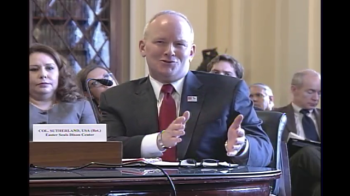In search of an improved transition for veterans
Testifying before a Congressional Committee is a great opportunity to inform and educate an important audience about a topic I’m very passionate about – ways to improve the military-to-civilian transition.
I was asked to provide my thoughts on the military’s Transition Assistance Program, also known as TAP. The completion of TAP is the beginning – not the end – of the service member’s reintegration process. In fact, the hardest work begins once final TAP sessions concludes. That’s because there are just some things that government can’t do.
The minute they step off the military base, veterans enter the community – and that is where the real transition starts. While the new TAP provides a good start, it could be improved.
A young Marine Lance Corporal named Gary who participated in the program last fall told me that he’d rate the information a B- or a C+. “It’d earn a higher grade had it been more specific to where I was going – even just sending me off with a list of key resources, such as the location of the VA or the job service.” Gary was equipped with basic tools, but there was never instruction, strategies or next steps for connecting to the community nearly 750 miles away that he would soon call home.
We ought to be measuring outcomes instead of completion so that we can review and adjust transition programs as needs evolve. For example, instead of recording a service member’s transition as a success because he or she completed the program, TAP should look at outcomes such as employment, home ownership, and financial solubility.
Sometimes the handoff to the community gets a shaky start. Paychecks aren’t deposited on time; housing falls through; the car breaks down. In these cases, the community becomes the final catchall. This could be made simpler if service members had the option of sharing their contact information with the community to which they are transitioning so they could learn about additional community-based assistance. To that end, Congress should authorize and fund grants so that communities can map available assets for veterans.
We must also recognize that reintegration challenges often surface months or years after the initial transition. Communities need to be there to support these veterans and their families before their situations turn into crisis and require more intensive and expensive interventions. Congress has done an effective job in developing and funding programs to assist veterans through community-based services and supports when they have hit crisis. But early-intervention models would be more efficient and productive. For example, Congress ought to extend and expand programs such as the Rural Veterans Coordination Pilot.
Every veteran matters, and their lives should be better because of our collective efforts at the national and community levels. This is my motivation, and I was honored to share it with Congress this past week.
To read Colonel Sutherland’s full testimony, visit the U.S. House of Representatives Committee on Veterans’ Affairs. Or watch the webcast of the hearing, including the Q&A session.







